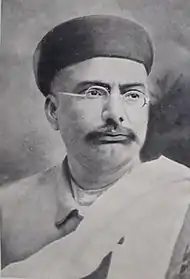Narmadashankar Mehta | |
|---|---|
 | |
| Born | Narmadashankar Devshankar Mehta 23 August 1871 Ahmedabad, British India |
| Died | 21 March 1939 (aged 67) |
| Occupation | Writer, historian, and administrator |
| Language | Gujarati |
| Children | Yashodhar Mehta |
Dewan Bahadur Narmadashankar Devshankar Mehta (23 August 1871 – 21 March 1939) was a Gujarati writer, historian of philosophy, and administrator from British India. He was a student of Anandshankar Dhruv, and a nephew of Balashankar Kantharia.
Biography
Mehta was born in Sathodara Nagar Brahmin family on 23 August 1871 in Ahmedabad, to his parents Devshankar, a revenue officer, and Rukshmani (Rukmini).[1]
After passing his matriculation exam in 1888, he graduated from Bombay University in 1894 with English and Sanskrit literature. He was appointed fellow at Gujarat College, Ahmedabad, where he became student of Anandshankar Dhruv, which led him to study Sanskrit culture and Indian philosophy.[1][2] In 1896, he joined revenue department at Ahmedabad as clerk, and was later appointed a deputy commissioner of municipality. At later point of his life, he served as a dewan of Khambhat state.[1]
In 1934, he suffered a paralytic stroke which caused his death five years later, on 21 March 1939.[1][2] His son Yashodhar Mehta was also a Gujarati writer and novelist.[3] Mehta was a nephew of Gujarati writer Balashankar Kantharia.[1]
Works
Mehta wrote his works in Gujarati, English and Sanskrit. He published around a hundred scholarly articles in various magazines about Hindu religion and Indian philosophy.[2] His writings are marked by clarity of thought, strictly scientific and objective approach and lucid style.[4]
He started his literary career by writing a play Sati Natak in 1885. In 1892, he translated into Gujarati Totakacharya's Śrutisārasamuddharaņa and Appayya Dikshita's Vairagyashataka. His Hind Tattvajnan No Itihas (History of Indian Philosophy), published in two parts in 1924 and 1925 respectively, is a historical narrative of Hindu philosophy. It was the first of its kind in the history of Gujarati literature. According to some scholars, it maintains the historical sequence of the Darshanas of Indian philosophy more correctly than Surendranath Dasgupta and Sarvepalli Radhakrishnan, and notes some historical facts that other scholars have failed to do. In 1932, he published Upanishadavicharana and Shakta Sampradaya (History of Shaktism). Suprajan Shastr and Sandhyakarma Vivaran are his other works.[1][4]
Dharmatatva-Vichar, edited by Anantrai Raval, was published posthumously in four volumes (1972, 1977, 1978 & 1980), which contains his writings on literature, religion and philosophy.[1]
See also
References
- 1 2 3 4 5 6 7 Shukla, Jayeshkumar R. (January 2002). Thaker, Dhirubhai (ed.). ગુજરાતી વિશ્વકોશ [Gujarati Encyclopedia] (in Gujarati). Vol. XV (1st ed.). Ahmedabad: Gujarat Vishvakosh Trust. pp. 510–511. OCLC 248968453.
- 1 2 3 Datta, Amaresh, ed. (1989). Encyclopaedia of Indian Literature: k to navalram. New Delhi: Sahitya Akademi. p. 2657. ISBN 978-81-260-1804-8.
- ↑ Shastri, Keshavram Kashiram (1977). ગુજરાતના સારસ્વતો Gujaratna Saraswato [Who's Who in Gujarati Literature] (in Gujarati) (1st ed.). Ahmedabad: Gujarat Sahitya Sabha. p. 101. OCLC 900401455.
- 1 2 Jhaveri, Mansukhlal Maganlal (1978). History of Gujarati Literature. New Delhi: Sahitya Akademi. p. 142. OCLC 462837743.
Further reading
- Jośī, Umāśaṅkara; Raval, Anantrai Manishankar; Mahetā, Yaśodhara, eds. (1968). દી. બ. નર્મદાશંકર મહેતા સ્મારક ગ્રંથ [Dewan Bahadur Narmadashankar Mehta Commemoration Volume]. Gurjara Grantharatna Kāryālaya. OCLC 22407448.